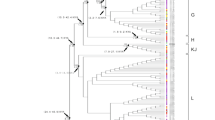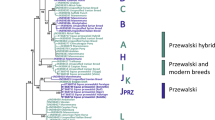Abstract
The Korean native horse (Jeju horse) is one of the most important animals in Korean historical, cultural, and economical viewpoints. In the early 1980s, the Jeju horse was close to extinction. The aim of this study is to explore the phylogenomics of Korean native horse focusing on spatio-temporal dynamics. We determined complete mitochondrial genome sequences for the first Korean native (n = 6) and additional Mongolian (n = 2) horses. Those sequences were analyzed together with 143 published ones using Bayesian coalescent approach as well as three different phylogenetic analysis methods, Bayesian inference, maximum likelihood, and neighbor-joining methods. The phylogenomic trees revealed that the Korean native horses had multiple origins and clustered together with some horses from four European and one Middle Eastern breeds. Our phylogenomic analyses also supported that there was no apparent association between breed or geographic location and the evolution of global horses. Time of the most recent common ancestor of the Korean native horse was approximately 13,200–63,200 years, which was much younger than 0.696 My of modern horses. Additionally, our results showed that all global horse lineages including Korean native horse existed prior to their domestication events occurred in about 6000–10,000 years ago. This is the first study on phylogenomics of the Korean native horse focusing on spatio-temporal dynamics. Our findings increase our understanding of the domestication history of the Korean native horses, and could provide useful information for horse conservation projects as well as for horse genomics, emergence, and the geographical distribution.



Similar content being viewed by others
References
Vilà C, Leonard JA, Götherström A, Marklund S, Sandberg K, Lidén K et al (2001) Widespread origins of domestic horse lineages. Science 291:474–477
Saccone C, Giorgi CD, Gissi C, Pesole G, Reyes A (1999) Evolutionary genomics in Metazoa: the mitochondrial DNA as a model system. Gene 238:195–209
Jansen T, Forster P, Levine MA, Oelke H, Hurles M, Renfrew C et al (2002) Mitochondrial DNA and the origins of the domestic horse. Proc Natl Acad Sci USA 99:10905–10910
Cieslak M, Pruvost M, Benecke N, Hofreiter M, Morales A, Reissmann M et al (2010) Origin and history of mitochondrial DNA lineages in domestic horses. PLoS ONE 5:e15311
Lippold S, Matzke NJ, Reissmann M, Hofreiter M (2011) Whole mitochondrial genome sequencing of domestic horses reveals incorporation of extensive wild horse diversity during domestication. BMC Evol Biol 11:328
Achilli A, Olivieri A, Soares P, Lancioni H, Kashani BH, Perego UA et al (2012) Mitochondrial genomes from modern horses reveal the major haplogroups that underwent domestication. Proc Natl Acad Sci USA 109:2449–2454
Der Sarkissian C, Ermini DL, Schubert M, Yang MA, Librado P, Fumagalli M et al (2015) Evolutionary genomics and conservation of the endangered Przewalski’s horse. Curr Biol 25:2577–2583
Nam DY (1969) Horse production in Cheju during Lee dynasty. In: Studies on Korean History, Vol 4. Korea History Research Society, College of Letters Sciences, Seoul National University Press, Seoul, p 77–131
Shin T K, Lee CK, Kim SH, Yang KC, Ko CH, Lee BM et al. (1992) An anatomy study of animal bones excavated in the Kwakji archaeological site in Cheju Island. Go-Moon-Wha 40:31–42
Oh MY, Ko MH, Kim GO, Oh YS, Kim SJ, Hong SS (1994) Phylogenetic relationships of Cheju native horses by mitochondrial DNA sequences. Mol Cells 4:13–20
Kim K-I, Yang Y-H, Lee S-S, Park C, Ma R, Bouzat JL et al (1999) Phylogenetic relationships of Cheju horses to other horse breeds as determined by mtDNA D-loop sequence polymorphism. Anim Genet 30:102–108
Jung Y-H, Han S-H, Shin T, Oh M-Y (2002) Genetic characterization of horse bone excavated from the Kwakji archaeological site, Jeju, Korea. Mol Cells 14:224–230
Yang YH, Kim KI, Cothran EG, Flannery AR (2002) Genetic diversity of Cheju horses (Equus caballus) determined by using mitochondrial DNA D-loop polymorphism. Biochem Genet 40:175–186
Xu S, Luosang J, Hua S, He J, Ciren A, Wang W et al (2007) High altitude adaptation and phylogenetic analysis of Tibetan horse based on the mitochondrial genome. J Genet Genomics 34:720–729
Katoh K, Misawa K, Kuma K, Miyata T (2002) MAFFT: a novel method for rapid multiple sequence alignment based on fast Fourier transform. Nucleic Acids Res 30:3059–3066
Hall TA (1999) BIOEDIT: a user-friendly biological sequence alignment editor and analysis program for windows 95/98/NT. Nucleic Acids Symp Ser 41:95–98
Posada D, Crandall KA (1998) Modeltest: testing the model of DNA substitution. Bioinformatics 14:817–818
Swofford DL (2003) PAUP: phylogenetic analysis using parsimony. Ver 4.0b10. Sinauer Associates, Sunderland
Ronquist F, Huelsenbeck JP (2003) MrBayes 3: Bayesian phylogenetic inference under mixed models. Bioinformatics 19:1572–1574
Guindon S, Gascuel O (2003) A simple, fast and accurate algorithm to estimate large phylogenies by maximum likelihood. Syst Biol 52:696–704
Saitou N, Nei M (1987) The neighbor-joining method: a new method for reconstructing phylogenetic trees. Mol Biol Evol 4:406–425
Felsenstein J (1995) PHYLIP: phylogeny inference package. Ver 3.572c. University of Washington, Seattle
Kimura M (1980) A simple method for estimating evolutionary rate of base substitution through comparative studies of nucleotide sequences. J Mol Evol 16:111–120
Strimmer K, von Haeseler A (1996) Quartet puzzling: a quartet maximum likelihood method for reconstructing tree topologies. Mol Biol Evol 13:964–969
Felsenstein J (1985) Confidence limits on the phylogenetics: an approach using the bootstrap. Evol Int J Org Evol 39:783–791
Drummond AJ, Rambaut A (2007) BEAST: Bayesian evolutionary analysis by sampling trees. BMC Evol Biol 7:214
Forstén A (1992) Mitochondrial-DNA time-table and the evolution of Equus: comparison of molecular and paleontological evidence. Ann Zool Fenn 28:301–309
Drummond AJ, Ho SY, Phillips MJ, Rambaut A (2006) Relaxed phylogenetics and dating with confidence. PLoS Bio 4:e88
Suchard MA, Weiss RE, Sinsheimer JS (2001) Bayesian selection of continuous- time Markov chain evolutionary models. Mol Biol Evol 18:1001–1013
Rambaut A (2012) Available at http://evolve.zoo.ox.ac.uk/beast
McGahern A, Bower M, Edwards C, Brophy PO, Sulimova G, Zakharov I et al (2006) Evidence for biogeographical patterning in mitochondrial DNA sequences in eastern horse populations. Anim Genet 37:494–497
Prystupa J, Hind P, Cothran E, Plante Y (2012) Maternal lineages in native Canadian equine populations and their relationship to the Nordic and Mountain and Moorland pony breeds. J Hered 103: 380–390
Winton CL, Hegarty MJ, McMahon R, Slavov GT, McEwan NR (2013) Genetic diversity and phylogenetic analysis of native mountain ponies of Britain and Ireland reveals a novel rare population. Ecol Evol 3:934–947
Warmuth V, Campana M, Eriksson A, Bower M, Barker G, Manica A (2013) Ancient trade routes shaped the genetic structure of horses in eastern Eurasia. Mol Ecol 22:534–5351
Rout PK, Joshi MB, Mandal A, Laloe D, Singh L, Thangaraj K (2008) Microsatellite-based phylogeny of Indian domestic goats. BMC Genet 9:11
Olivieri A, Gandini F, Achilli A, Fichera A, Rizzi E, Bonfiglio S et al (2015) Mitogenomes from Egyptian cattle breeds: new clues on the origin of haplogroup Q and the early spread of Bos taurus from the near east. PLoS ONE 10:e0141170
Achilli A, Bonfiglio S, Olivieri A, Malusà A, Pala M, Hooshiar Kashani B et al (2009) The multifaceted origin of taurine cattle reflected by the mitochondrial genome. PLoS ONE 4:e5753
Acknowledgements
This work was carried out with the support of “Cooperative Research Program for Agriculture Science & Technology Development (Project No. PJ01040603)” Rural Development Administration, Republic of Korea.
Author information
Authors and Affiliations
Corresponding authors
Electronic supplementary material
Below is the link to the electronic supplementary material.
Rights and permissions
About this article
Cite this article
Yoon, S.H., Kim, J., Shin, D. et al. Complete mitochondrial genome sequences of Korean native horse from Jeju Island: uncovering the spatio-temporal dynamics. Mol Biol Rep 44, 233–242 (2017). https://doi.org/10.1007/s11033-017-4101-8
Received:
Accepted:
Published:
Issue Date:
DOI: https://doi.org/10.1007/s11033-017-4101-8




